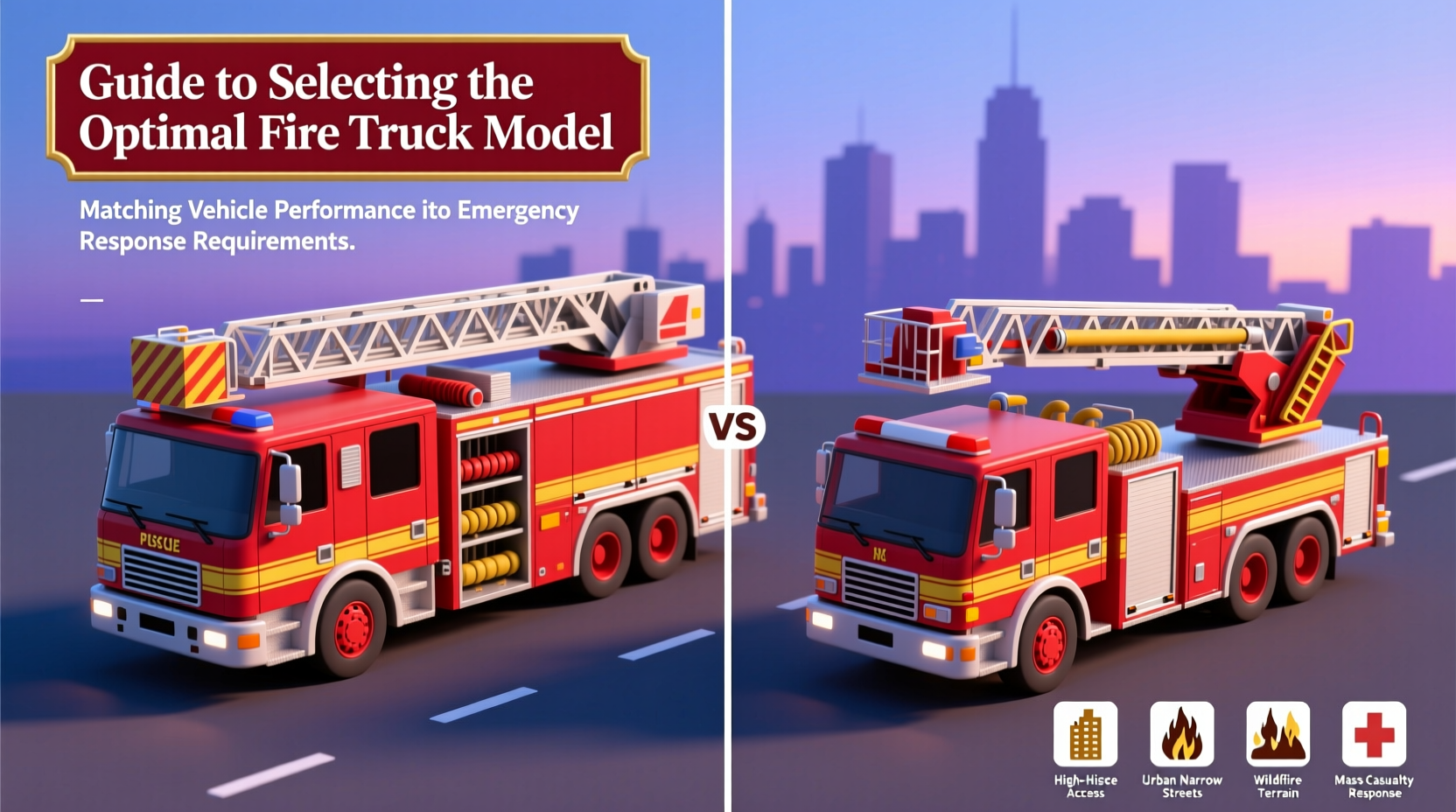Selecting the right fire truck is not a one-size-fits-all decision. Departments vary in size, geography, response demands, and budget constraints—each influencing what type of apparatus will perform most effectively. Whether you're equipping a metropolitan fire station, a rural volunteer unit, or an industrial emergency team, understanding the functional differences between fire truck models is essential for safety, efficiency, and long-term operational success.
A well-chosen fire truck enhances response speed, improves firefighter safety, and ensures compatibility with local infrastructure and incident profiles. This guide breaks down the key considerations, compares top models, and provides actionable insights to help you make an informed purchase tailored to your department’s unique needs.
Understanding Fire Truck Types and Their Roles

Fire trucks are categorized by function, design, and NFPA (National Fire Protection Association) standards. The primary types include:
- Engine (Pumper) Trucks: Carry water, hoses, and pumps for direct firefighting. Ideal for structural fires.
- Ladder Trucks (Tillers & Aerials): Equipped with extendable ladders or platforms for high-rise access and ventilation.
- Rescue Trucks: Focused on technical rescue operations—vehicle extrication, confined space, trench, etc.
- Wildland Fire Engines: Compact, off-road capable units designed for brush and forest fires.
- Industrial/ARFF Trucks: Airport crash tenders or facility-specific rigs built for hazardous materials and fuel fires.
The choice begins with assessing your most common call types. Urban departments often prioritize aerial ladder trucks for multi-story buildings, while rural areas may benefit more from wildland engines with large water tanks and four-wheel drive.
Key Factors in Selecting the Right Model
Beyond type, several critical factors determine which fire truck model fits your department:
1. Geographic and Infrastructure Constraints
Narrow streets, low bridges, weight-restricted roads, and terrain affect maneuverability and chassis selection. For example, cities like Boston or San Francisco require shorter wheelbase tiller trucks for tight turns. Rural departments need four-wheel drive and higher ground clearance.
2. Water and Pump Capacity Needs
Pump capacity is measured in gallons per minute (GPM). Standard engines range from 1,000–2,000 GPM. Areas without hydrants need larger onboard water tanks (500–1,000 gallons), whereas urban zones can rely on hydrant-fed systems with smaller tanks.
3. Personnel and Equipment Load
How many firefighters respond per call? Do you carry specialized gear like hazmat suits or hydraulic tools? Crew cab configurations and compartment layout must support staffing and equipment needs without overcrowding.
4. Budget and Lifecycle Costs
New fire trucks range from $300,000 (basic wildland) to over $1 million (custom aerial towers). Factor in maintenance, fuel efficiency, parts availability, and expected service life (typically 15–20 years).
“Buying the cheapest option often leads to higher long-term costs due to downtime and repairs.” — Captain Rafael Mendez, Fire Apparatus Safety Officer, Phoenix FD
Comparison Table: Top Fire Truck Models by Use Case
| Model | Type | Best For | Pump Capacity | Tank Size | Approx. Price |
|---|---|---|---|---|---|
| Pierce Arrow XT | Aerial Ladder | Urban high-rise | 2,000 GPM | 500 gal | $1.2M+ |
| E-One Typhoon HP | Pumper | Suburban departments | 1,500 GPM | 750 gal | $750,000 |
| KME Severe Service | Rescue/Heavy Pumper | Technical rescue | 1,250 GPM | 500 gal | $900,000 |
| Freightliner M2 4x4 Wildland | Brush Engine | Rural/wildfire | 500 GPM | 1,000 gal | $325,000 |
| Oshkosh Striker ARFF | Airport Tiller | Airport emergencies | 3,000 GPM + foam | 1,800 gal water / 420 gal foam | $1.8M+ |
Step-by-Step Guide to Choosing Your Fire Truck
- Assess Call Volume and Type: Analyze your last 12 months of incident reports. What percentage were structure fires, vehicle rescues, or medical assists?
- Determine Staffing Levels: Choose a cab configuration (e.g., 4-person crew cab vs. walk-in rescue) based on average responders per call.
- Map Response Zones: Identify narrow roads, bridges, steep grades, or remote areas that impact vehicle specs.
- Set Budget Parameters: Include funding sources—grants, municipal allocations, or fundraising—over a 5-year horizon.
- Shortlist Manufacturers: Evaluate Pierce, E-One, KME, Rosenbauer, and Ferrara based on regional service support and warranty terms.
- Customize Configuration: Work with vendors on pump location, hose bed layout, lighting, and SCBA mounting.
- Test Drive and Review: Attend demonstrations or visit departments using similar models.
- Finalize Funding and Order: Submit grant applications early and lock delivery timelines before peak fire seasons.
Real Example: How a Small Town Made the Right Choice
The volunteer fire department in Pine Ridge, population 3,200, faced recurring delays during wildfires due to inadequate water supply and poor off-road mobility. Their old pumper had a 300-gallon tank and rear-wheel drive, limiting access to forest trails.
After analyzing five years of call data—80% wildland fires, 15% vehicle accidents—they opted for a Freightliner M2 4x4 with a 1,000-gallon tank, 500 GPM pump, and skid-resistant undercarriage. Though the initial cost was $325,000, a FEMA Assistance to Firefighters Grant covered 75%. Response times dropped by 40%, and the truck successfully contained two fast-moving brush fires within the first year.
This case underscores the importance of aligning vehicle capability with actual operational demand—not perceived prestige or neighboring departments’ choices.
Checklist: Before You Finalize Your Fire Truck Purchase
- ✅ Verified all dimensions fit existing bay doors and turnarounds
- ✅ Confirmed pump and tank specs meet NFPA 1901 standards
- ✅ Evaluated manufacturer’s local service and parts network
- ✅ Included training for new technology (e.g., CAFS, thermal imaging integration)
- ✅ Secured at least 80% of funding before signing contract
- ✅ Designed ergonomics for firefighter safety (step height, handrails, compartment reach)
- ✅ Planned for future upgrades (compartments for drones, EV charging ports)
Frequently Asked Questions
Can we modify a used fire truck instead of buying new?
Yes, but carefully. Used trucks may have hidden wear in pumps or chassis. Rebuilding can cost up to 60% of a new unit. Only consider this if the core system is sound and certified by a qualified inspector.
What’s the difference between a tiller truck and a straight aerial?
A tiller truck has a separate steering axle at the rear, operated by a second driver. It allows tighter turns in dense urban areas. Straight aerials are simpler to operate but require wider turning radii.
How long does it take to receive a custom fire truck?
Lead times vary by manufacturer and complexity. Standard pumpers: 12–14 months. Custom aerials or ARFF vehicles: 18–24 months. Plan procurement at least two years before retirement of current units.
Conclusion: Make a Decision That Serves Your Community
Choosing the best fire truck isn’t about acquiring the largest or most advanced model—it’s about matching capability to real-world demands. A thoughtful selection process considers geography, incident trends, personnel, and financial sustainability. Whether you’re protecting a bustling downtown or a remote mountain community, the right fire truck becomes an extension of your team’s expertise and commitment.









 浙公网安备
33010002000092号
浙公网安备
33010002000092号 浙B2-20120091-4
浙B2-20120091-4
Comments
No comments yet. Why don't you start the discussion?